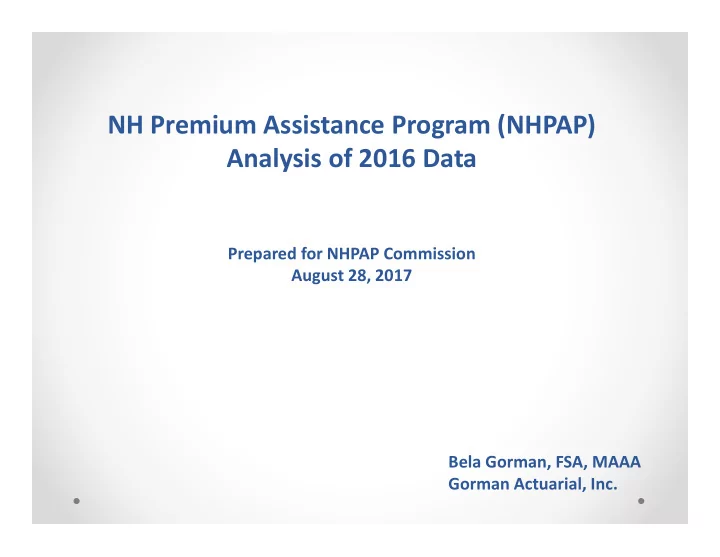

NH Premium Assistance Program (NHPAP) Analysis of 2016 Data Prepared for NHPAP Commission August 28, 2017 Bela Gorman, FSA, MAAA Gorman Actuarial, Inc.
Introduction � Gorman Actuarial, Inc � Formed in 2006 � Lead Consultant: Bela Gorman, FSA, MAAA � Over 25 years of health care experience � Client list include state agencies in MA, ME, RI, NY,and NH � Worked for two largest insurers in MA � Gorman Actuarial Relevant Engagements � MA Individual & Small Group Market Merger Study-2006 � Followed by similar studies in Maine and New York � Post ACA, Merger studies performed for NH, NV, WI, WY, MN, TN, MA including impact of small group market and the 51-100 markets � Currently involved with a durational study that analyzes Medicaid Expansion populations: 3 insurance carriers, spanning 5 to 7 states, 9 different data sets ���������������������� �
Agenda I. Background II. Data Sources III. Membership IV. Allowed Claims Costs V. Demographics VI. Plan Design VII. Induced Demand VIII. Adjusted Claims Cost IX. Impact of PAP on Individual Market X. Risk Adjustment XI. Summary ���������������������� �
Background � PAP program became part of NH’s Individual Market in January 2016 � Significantly increased size of Individual Market � Affordable Care Act’s (ACA) single risk pool requirements apply: � Premium rates for Individual Market based on medical expenditures of the combined PAP and Non-PAP populations � PAP members are part of the ACA’s risk adjustment program � 2016 analysis provides historical comparisons of the enrollees within the PAP program and the Non-PAP enrollees � Significant changes in 2018 may materially impact future comparisons of the PAP program enrollees and the Non-PAP enrollees ���������������������� �
Data Sources � Annual Hearing Process � Data Request & Supplemental Data Request � Requests have been designed and enhanced by Gorman Actuarial (GA) to collect PAP enrollee data separately from Non-PAP enrollee data Data first received between June 30 th and mid-July � � GA still reviewing and checking insurer data � Most of the Claims Data has been validated � ACA Risk Adjustment Reports � Each insurer provided their ACA risk adjustment reports to GA � GA aggregated results ���������������������� �
2016 Membership � For CY 2016, 42% of the Individual Market (single risk pool) was enrolled in the PAP program � As of March 2017, there were 102K enrollees in the Individual Market � In addition, there were approximately 7,000 grandfathered and transitional enrollees, which are not part of the Individual Market (single risk pool) ���������������������� �
2016 Claims Costs � PAP medical & pharmacy expenditures were 26% higher than Non-PAP � Calculated based on allowed claims (includes member cost sharing and insurer payments) per member per month � Differences can be due to factors such as age, plan design (i.e., induced demand), and health status ���������������������� �
2016 Age Demographics � PAP population is younger than Non-PAP population � Avg. Age is 38 for PAP vs. 43 for Non-PAP � 35% of PAP between 19-29 vs. 14% of Non-PAP; � 24% of PAP age 50+ vs. 46% of Non-PAP � Non-PAP age factor is 17% higher than PAP � Based on age alone, expect Non-PAP claims costs to be higher than PAP claims costs ���������������������� �
2016 Plan Design Differences Note: Assuming on and off exchange distribution the same � 100% of PAP population enrolled in Platinum Equivalent plans, whereas 57% of Non-PAP enrolled in Bronze and Silver � Non-PAP distribution reflects cost sharing reduction (CSR) plans � Enrollment in Platinum plans suggest greater utilization of health care services � Less barriers to care due to lower cost sharing � Induced demand effect ���������������������� �
2016 Induced Demand � PAP’s induced demand “factor” is 9% higher than the Non-PAP population � Suggests that the PAP population’s claims costs are expected to be 9% higher than Non-PAP due to induced demand differences � Induced demand factors are those used in federal risk adjustment methodology ���������������������� ��
2016 Adjusted Allowed Claims � After adjusting for age and induced demand: � PAP’s adjusted claims expenditures are 39% higher than the Non-PAP adjusted claims expenditures ���������������������� ��
Impact of PAP on Individual Market � Non-PAP’s adjusted 2016 allowed claims are $234 PMPM and the combined PAP and Non-PAP population’s adjusted allowed claims are $272 PMPM � If PAP population was not part of Individual Market, overall adjusted medical expenditures would decrease 14% , which would have a downward impact on premiums � Impact may be very different in 2018 � Minuteman exiting the market � HPHC withdrawing full network plan and reducing service area � Significant premium increases in the market � Loose individual mandate enforcement � Price sensitive “healthy” individuals may exit the market, which could reduce the claims costs gap between PAP and Non-PAP populations. ���������������������� ��
2016 Risk Adjustment $41M Note: Approximately 82% of enrollees within PAP plan offerings are PAP enrollees � Enrollees within the PAP plan offerings risk score is 27% higher than enrollees in the Non-PAP plan offerings � $41 million was transferred from Non-PAP plans to PAP plans in 2016 through the federal risk adjustment program. ���������������������� ��
Summary � For 2016, all indicators suggest that PAP enrollees have higher morbidity than Non-PAP enrollees. � Key features of PAP population: � Younger � Enrolled in more comprehensive plans � Higher risk scores � Greater claims costs � Due to changes in the market, 2018 may look very different from 2016 � Model the impact of individuals exiting the Non-PAP market � Must also model the impact of churn in the PAP market � The impact of these changes could impact the relationship between the PAP and Non-PAP populations ���������������������� ��
Recommend
More recommend